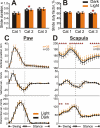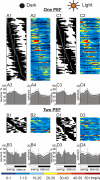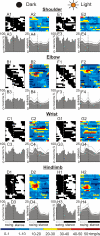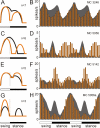Effect of light on the activity of motor cortex neurons during locomotion
- PMID: 23680161
- PMCID: PMC3787125
- DOI: 10.1016/j.bbr.2013.05.004
Effect of light on the activity of motor cortex neurons during locomotion
Abstract
The motor cortex plays a critical role in accurate visually guided movements such as reaching and target stepping. However, the manner in which vision influences the movement-related activity of neurons in the motor cortex is not well understood. In this study we have investigated how the locomotion-related activity of neurons in the motor cortex is modified when subjects switch between walking in the darkness and in light. Three adult cats were trained to walk through corridors of an experimental chamber for a food reward. On randomly selected trials, lights were extinguished for approximately 4s when the cat was in a straight portion of the chamber's corridor. Discharges of 146 neurons from layer V of the motor cortex, including 51 pyramidal tract cells (PTNs), were recorded and compared between light and dark conditions. It was found that while cats' movements during locomotion in light and darkness were similar (as judged from the analysis of three-dimensional limb kinematics and the activity of limb muscles), the firing behavior of 49% (71/146) of neurons was different between the two walking conditions. This included differences in the mean discharge rate (19%, 28/146 of neurons), depth of stride-related frequency modulation (24%, 32/131), duration of the period of elevated firing ([PEF], 19%, 25/131), and number of PEFs among stride-related neurons (26%, 34/131). 20% of responding neurons exhibited more than one type of change. We conclude that visual input plays a very significant role in determining neuronal activity in the motor cortex during locomotion by altering one, or occasionally multiple, parameters of locomotion-related discharges of its neurons.
Copyright © 2013 The Authors. Published by Elsevier B.V. All rights reserved.
Figures










References
Publication types
MeSH terms
Grants and funding
LinkOut - more resources
Full Text Sources
Other Literature Sources
Miscellaneous

